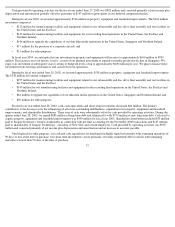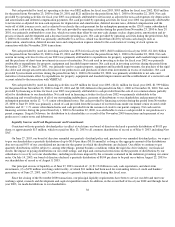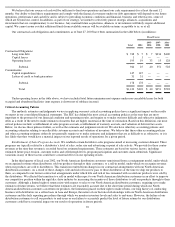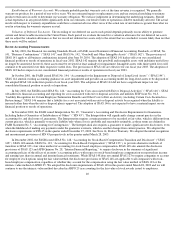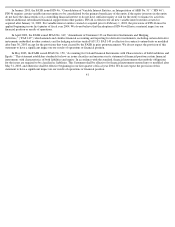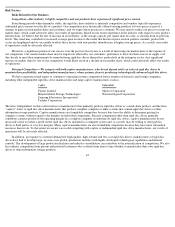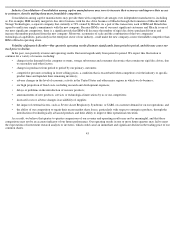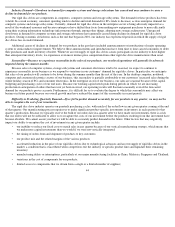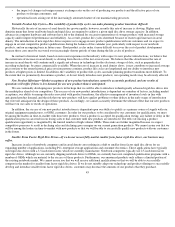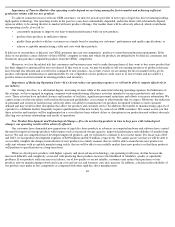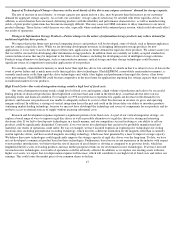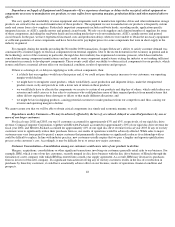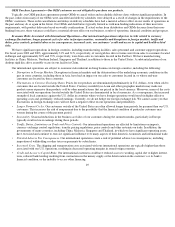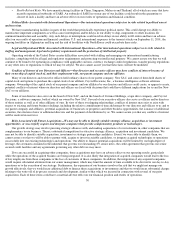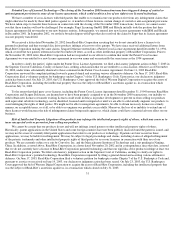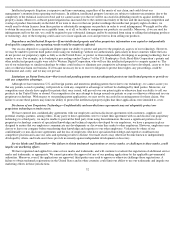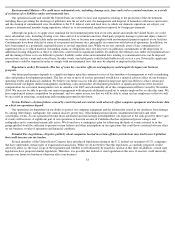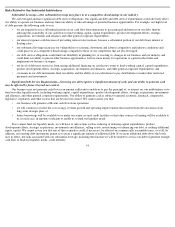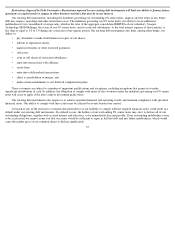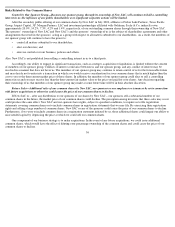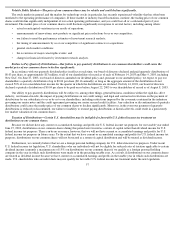Seagate 2002 Annual Report Download - page 52
Download and view the complete annual report
Please find page 52 of the 2002 Seagate annual report below. You can navigate through the pages in the report by either clicking on the pages listed below, or by using the keyword search tool below to find specific information within the annual report.
Impact of Technological Change—Increases in the areal density of disc drives may outpace customers’ demand for storage capacity.
The rate of increase in areal density, or storage capacity per square inch on a disc, may be greater than the increase in our customers’
demand for aggregate storage capacity. As a result, our customers’ storage capacity needs may be satisfied with fewer rigid disc drives. In
addition, as areal densities have increased, delivering products with the reliability and performance characteristics, as well as manufacturing
yields, of prior product generations has become increasingly difficult. This may cause our OEM customers to delay transitions to our newer
product offerings. These factors could decrease our sales, especially when combined with continued price erosion, which could adversely affect
our results of operations.
Changes in Information Storage Products—Future changes in the nature of information storage products may reduce demand for
traditional rigid disc drive products.
We expect that in the future new personal computing devices and products will be developed, some of which, such as Internet appliances,
may not contain a rigid disc drive. While we are investing development resources in designing information storage products for new
applications, it is too early to assess the impact of these new applications on future demand for rigid disc drive products. We cannot assure you
that we will be successful in developing other information storage products. In addition, there are currently no widely accepted standards in
various technical areas that may be important to the future of our business, including the developing sector of intelligent storage solutions.
Products using alternative technologies, such as semiconductor memory, optical storage and other storage technologies could become a
significant source of competition to particular applications of our products.
For example, semiconductor memory is much faster than rigid disc drives, but currently is volatile in that it is subject to loss of data in the
event of power failure and is much more costly than rigid disc drive technologies. Flash EEPROM, a nonvolatile semiconductor memory, is
currently much more costly than rigid disc drive technologies and, while it has higher read performance than rigid disc drives, it has lower
write performance. Flash EEPROM could become competitive in the near future for applications requiring less storage capacity than is required
in traditional markets for our products.
High Fixed Costs
—Our vertical integration strategy entails a high level of fixed costs.
Our vertical integration strategy entails a high level of fixed costs and requires a high volume of production and sales to be successful.
During periods of decreased production, these high fixed costs have had, and could in the future have, a material adverse effect on our
operating results and financial condition. For example, in 1998 our predecessor experienced a significant decrease in the demand for its
products, and because our predecessor was unable to adequately reduce its costs to offset this decrease in revenue, its gross and operating
margins suffered. In addition, a strategy of vertical integration has in the past and could in the future delay our ability to introduce products
containing market-leading technology, because we may not have developed the technology and source of components for our products and do
not have access to external sources of supply without incurring substantial costs.
Research and development expenses represent a significant portion of our fixed costs. As part of our vertical integration strategy, we
explore a broad range of ways to improve rigid disc drives as well as possible alternatives to rigid disc drives for storing and retrieving
electronic data. If we fail to develop new technologies in a timely manner, and our competitors succeed in doing so, our ability to sell our
products could be significantly diminished. Conversely, if we over invest in technologies that can never be profitably manufactured and
marketed, our results of operations could suffer. By way of example, we have incurred expenses in exploring new technologies for storing
electronic data, including perpendicular recording technology, which involves a different orientation for the magnetic field than is currently
used in rigid disc drives, and heat assisted magnetic recording technology, which uses heat generated by a laser to improve storage capacity.
We believe these new technologies could significantly improve the storage capacity of rigid disc drives over the long-term. To date, we have
not yet developed a commercial product based on these technologies. Furthermore, based on our recent experience in the industry with respect
to new product introductions, we believe that the rate of increase of areal density is slowing as compared to its previous levels, which has
lengthened the life cycles of existing products and may further postpone returns on our investments in new technologies. If we have invested
too much in new technologies, our results of operations could be adversely affected. In addition, as we replace our existing assets with new,
higher cost assets, we expect that our depreciation expense will increase, which will contribute to our high level of fixed costs and reduce our
earnings. This could cause the market price of our common shares to decline.
47


